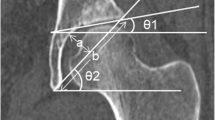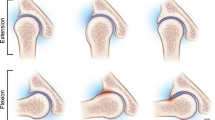Abstract
Objective
To describe a benign focus of increased activity in the acetabular fossa (the acetabular fossa hot spot, AFHS) on 18 F-FDG PET/CT that can mimic a neoplasm.
Materials and methods
18F-FDG PET/CT images from four patient populations were examined. Group 1 (n = 13) was collected from a search of radiology reports and used to define the AFHS and for hypothesis generation. Group 2 (n = 1,150) was used for prevalence of AFHS. Group 3 (n = 1,213) had PET/CT and MRI pelvis within a week of each other and was used to correlate metabolic and anatomic findings. Group 4 (n = 100) was used to generate the control group. Data were collected on demographics, common comorbidities, underlying cancer diagnosis and status, and hip symptoms.
Results
Prevalence of AFHS was 0.36 % (95 % CI 0.10–0.91 %). None progressed to malignancy or was associated with cancer status. The majority (71 %) were on the left, and 6 % were bilateral. Mean SUVmax of the AFHS was 4.8 (range, 2.7–7.8). Male patients were more likely to have the AFHS (OR = 8.69, 95 % CI 1.88–40.13). There was no difference with respect to other collected data, including hip symptoms. Average minimum duration of AFHS was 346 days (range, 50–1,010 days). Readers did not detect corresponding hip abnormalities on MRIs.
Conclusions
AFHS is a benign finding that may be caused by subclinical ligamentum teres injury, focal synovitis, or degeneration of acetabular fossa fat. Despite uncertainty regarding its etiology, recognition of AFHS as a benign finding can prevent morbidity associated with unnecessary biopsy or initiation of therapy.




Similar content being viewed by others
References
Lynch TS, Terry MA, Bedi A, Kelly BT. Hip arthroscopic surgery: patient evaluation, current indications, and outcomes. Am J Sports Med. 2013;41(5):1174–89.
Domb BG, Martin DE, Botser IB. Risk factors for ligamentum teres tears. Arthrosc: J Arthrosc Relat Surg: Off Publ Arthrosc Assoc North Am Int Arthrosc Assoc. 2013;29(1):64–73.
Keene GS, Villar RN. Arthroscopic anatomy of the hip: an in vivo study. Arthrosc: J Arthrosc Relat Surg: Off Publ Arthrosc Assoc North Am Int Arthrosc Assoc. 1994;10(4):392–9.
Brown AK, Conaghan PG, Karim Z, Quinn MA, Ikeda K, Peterfy CG, et al. An explanation for the apparent dissociation between clinical remission and continued structural deterioration in rheumatoid arthritis. Arthritis Rheum. 2008;58(10):2958–67.
Byrd JW, Jones KS. Adhesive capsulitis of the hip. Arthrosc: J Arthrosc Relat Surg: Off Publ Arthrosc Assoc North Am Int Arthrosc Assoc. 2006;22(1):89–94.
Murphy WA, Siegel MJ, Gilula LA. Arthrography in the diagnosis of unexplained chronic hip pain with regional osteopenia. AJR Am J Roentgenol. 1977;129(2):283–7.
Goldman AB, Katz MC, Freiberger RH. Posttraumatic adhesive capsulitis of the ankle: arthrographic diagnosis. AJR Am J Roentgenol. 1976;127(4):585–8.
de Abreu MR, Falcao M, Sprinz C, Furian R, Marczyk LR. Adhesive capsulitis of the knee. Skeletal Radiol. 2013;42(5):741–6.
Sopov V, Bernstine H, Stern D, Yefremov N, Sosna J, Groshar D. Spectrum of focal benign musculoskeletal 18 F-FDG uptake at PET/CT of the shoulder and pelvis. AJR Am J Roentgenol. 2009;192(4):1029–35.
Sampatchalit S, Chen L, Haghighi P, Trudell D, Resnick DL. Changes in the acetabular fossa of the hip: MR arthrographic findings correlated with anatomic and histologic analysis using cadaveric specimens. AJR Am J Roentgenol. 2009;193(2):W127–33.
Turhan E, Doral MN, Atay AO, Demirel M. A giant extrasynovial osteochondroma in the infrapatellar fat pad: end-stage Hoffa’s disease. Arch Orthop Trauma Surg. 2008;128(5):515–9.
Kashyap R, Lau E, George A, Seymour JF, Lade S, Hicks RJ, et al. High FDG activity in focal fat necrosis: a pitfall in interpretation of posttreatment PET/CT in patients with non-Hodgkin lymphoma. Eur J Nucl Med Mol Imaging. 2013;40(9):1330–6.
Cronin CG, Prakash P, Daniels GH, Boland GW, Kalra MK, Halpern EF, et al. Brown fat at PET/CT: correlation with patient characteristics. Radiology. 2012;263(3):836–42.
Acknowledgments
The authors would like to thank Dr. Naveen Garg for the RIS database search. The work was partially supported by the NIH/NCI under award number P30CA016672 and used the biostatistics research group.
Conflict of interest
The authors have no conflicts of interest to disclose.
Author information
Authors and Affiliations
Corresponding author
Rights and permissions
About this article
Cite this article
Kubicki, S.L., Richardson, M.L., Martin, T. et al. The acetabular fossa hot spot on 18 F-FDG PET/CT: epidemiology, natural history, and proposed etiology. Skeletal Radiol 44, 107–114 (2015). https://doi.org/10.1007/s00256-014-2011-6
Received:
Revised:
Accepted:
Published:
Issue Date:
DOI: https://doi.org/10.1007/s00256-014-2011-6




